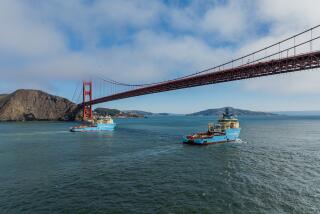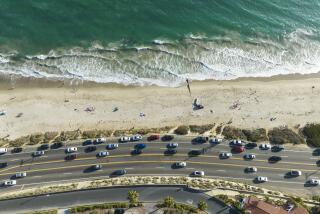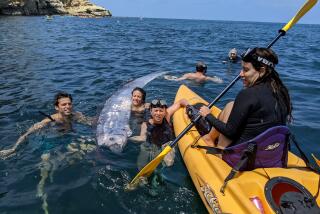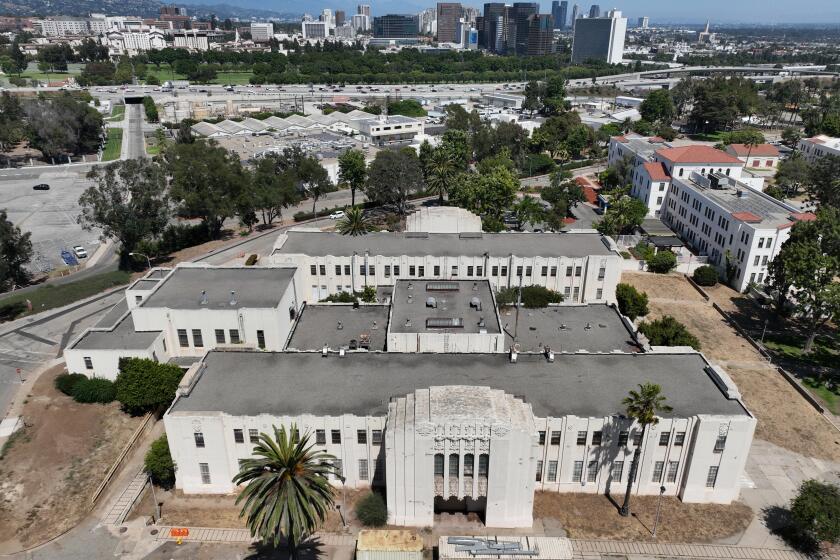Redondo Beach begins cleanup of dead sardines
A day after waking up to find a silvery carpet of dead fish on the surface of King Harbor, Redondo Beach set about the enormous task of ridding the marina of an estimated 1 million sardine carcasses before they started to decay.
City officials said Wednesday that it would take days and cost at least $100,000 to clean up King Harbor after the sudden fish die-off that began Monday evening. The city declared a local emergency in an effort to obtain state and county aid for the cleanup.
A crew of 200 workers has already removed more than 35 tons of fish, mostly by skimming the water’s surface. But an additional 30 tons — and perhaps more — are believed to have collected in a 2-foot-thick layer on the bottom of the harbor, about 20 feet below.
The variety of fish-removal techniques being explored to bring the submerged fish to the surface gave the cleanup the look of a frantic lab experiment.
Rowboats and firefighting vessels floated slowly through the marina dragging nets behind them as dozens of volunteers went from slip to slip scooping floating clusters of sardines with fishing nets and plucking individual, hot-dog-sized fish from the water.
Workers aimed high-pressure hoses at the harbor bottom to churn up the dead fish for a diver to capture and a Harbor Patrol boat revved its outboard motors to stir up the water and bring fish to the surface to be scooped up in nets. When the tide dropped, sewer vacuum trucks arrived to suck fish from the edges of the harbor with a long plastic hose that had the appearance of an elephant’s trunk.
Beyond the powerful stench expected to be unleashed once the fish start to rot and float to the surface, oxygen-eating bacteria could cause oxygen levels to dip again and kill anything else living in the harbor, such as mackerel and perch. The decay also could boost nutrients in the harbor, leading to an algae bloom that could again deplete the oxygen supply.
Hence the rush to remove as many fish as possible from the harbor and deposit them in plastic-lined dumpsters. From there, the carcasses will be taken by the truckload to a facility in the Victorville area to be processed into organic compost.
“The quicker we remove the decaying fish the better opportunity we have for recovery,” said Bill Workman, Redondo Beach’s city manager. “Time is of the essence; we have to move quickly.
The prevailing theory among scientists and wildlife officials is that something — windy conditions, predators or perhaps a column of oxygen-poor water in the ocean — forced masses of sardines into the harbor as a storm blew in Monday evening. Their huge numbers in such a confined area caused oxygen levels to suddenly plummet below life-sustaining levels.
The state Department of Fish and Game and USC marine biologists have found no evidence of significant water pollution, toxins or algal blooms, the usual culprits in fish kills.
USC scientists said they expect to be able to pin down the exact cause of the die-off because of monitoring equipment installed in the harbor after a 2005 fish kill that followed an algae bloom known as a red tide. In that episode, decomposing flesh floated around the harbor for weeks and plagued the area with a stink that frustrated surrounding restaurants and led some boaters to complain of feeling sick.
City officials said they were working to limit such irritations this time around, in part by using a greater, more effective repertoire of fish-removal techniques. The city plans, for instance, to hire a firm in the next few days to gently vacuum the hard-to-get deposits of fish on the harbor floor.
The conservation group Heal the Bay, worried about the fish-clogged waters continuing to degrade water quality, is encouraging volunteers to show up at the harbor over the next few days to help with the surface-level cleanup.
More to Read
Sign up for Essential California
The most important California stories and recommendations in your inbox every morning.
You may occasionally receive promotional content from the Los Angeles Times.











